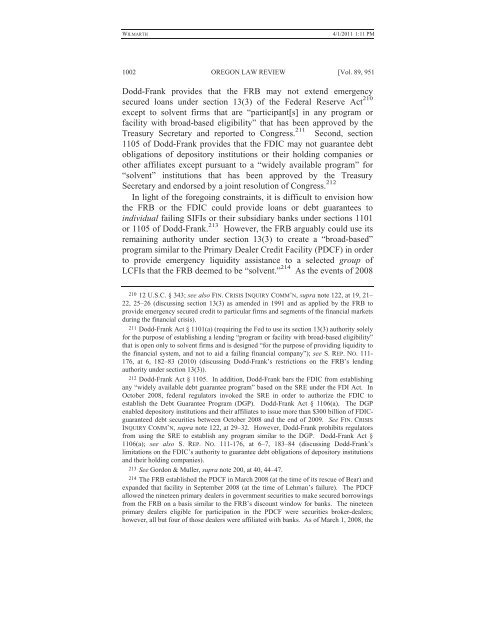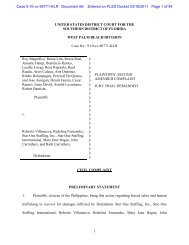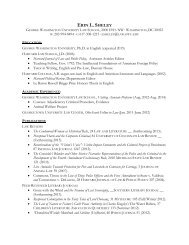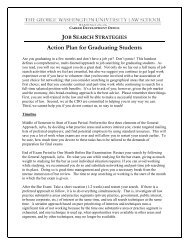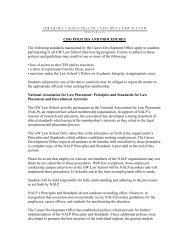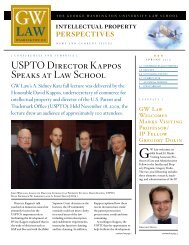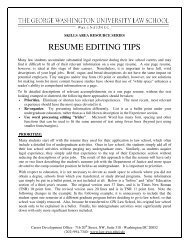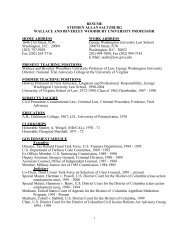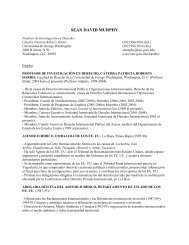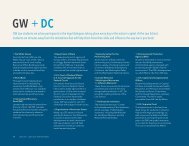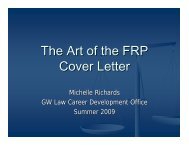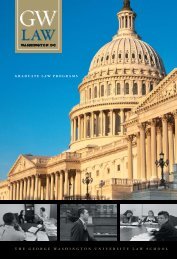CLE Materials for Panel #1 - George Washington University Law ...
CLE Materials for Panel #1 - George Washington University Law ...
CLE Materials for Panel #1 - George Washington University Law ...
You also want an ePaper? Increase the reach of your titles
YUMPU automatically turns print PDFs into web optimized ePapers that Google loves.
WILMARTH<br />
4/1/2011 1:11 PM<br />
1002 OREGON LAW REVIEW [Vol. 89, 951<br />
Dodd-Frank provides that the FRB may not extend emergency<br />
secured loans under section 13(3) of the Federal Reserve Act 210<br />
except to solvent firms that are “participant[s] in any program or<br />
facility with broad-based eligibility” that has been approved by the<br />
Treasury Secretary and reported to Congress. 211 Second, section<br />
1105 of Dodd-Frank provides that the FDIC may not guarantee debt<br />
obligations of depository institutions or their holding companies or<br />
other affiliates except pursuant to a “widely available program” <strong>for</strong><br />
“solvent” institutions that has been approved by the Treasury<br />
Secretary and endorsed by a joint resolution of Congress. 212<br />
In light of the <strong>for</strong>egoing constraints, it is difficult to envision how<br />
the FRB or the FDIC could provide loans or debt guarantees to<br />
individual failing SIFIs or their subsidiary banks under sections 1101<br />
or 1105 of Dodd-Frank. 213 However, the FRB arguably could use its<br />
remaining authority under section 13(3) to create a “broad-based”<br />
program similar to the Primary Dealer Credit Facility (PDCF) in order<br />
to provide emergency liquidity assistance to a selected group of<br />
LCFIs that the FRB deemed to be “solvent.” 214 As the events of 2008<br />
210 12 U.S.C. § 343; see also FIN.CRISIS INQUIRY COMM’N, supra note 122, at 19, 21–<br />
22, 25–26 (discussing section 13(3) as amended in 1991 and as applied by the FRB to<br />
provide emergency secured credit to particular firms and segments of the financial markets<br />
during the financial crisis).<br />
211 Dodd-Frank Act § 1101(a) (requiring the Fed to use its section 13(3) authority solely<br />
<strong>for</strong> the purpose of establishing a lending “program or facility with broad-based eligibility”<br />
that is open only to solvent firms and is designed “<strong>for</strong> the purpose of providing liquidity to<br />
the financial system, and not to aid a failing financial company”); see S. REP. NO. 111-<br />
176, at 6, 182–83 (2010) (discussing Dodd-Frank’s restrictions on the FRB’s lending<br />
authority under section 13(3)).<br />
212 Dodd-Frank Act § 1105. In addition, Dodd-Frank bars the FDIC from establishing<br />
any “widely available debt guarantee program” based on the SRE under the FDI Act. In<br />
October 2008, federal regulators invoked the SRE in order to authorize the FDIC to<br />
establish the Debt Guarantee Program (DGP). Dodd-Frank Act § 1106(a). The DGP<br />
enabled depository institutions and their affiliates to issue more than $300 billion of FDICguaranteed<br />
debt securities between October 2008 and the end of 2009. See FIN. CRISIS<br />
INQUIRY COMM’N, supra note 122, at 29–32. However, Dodd-Frank prohibits regulators<br />
from using the SRE to establish any program similar to the DGP. Dodd-Frank Act §<br />
1106(a); see also S. REP. NO. 111-176, at 6–7, 183–84 (discussing Dodd-Frank’s<br />
limitations on the FDIC’s authority to guarantee debt obligations of depository institutions<br />
and their holding companies).<br />
213 See Gordon & Muller, supra note 200, at 40, 44–47.<br />
214 The FRB established the PDCF in March 2008 (at the time of its rescue of Bear) and<br />
expanded that facility in September 2008 (at the time of Lehman’s failure). The PDCF<br />
allowed the nineteen primary dealers in government securities to make secured borrowings<br />
from the FRB on a basis similar to the FRB’s discount window <strong>for</strong> banks. The nineteen<br />
primary dealers eligible <strong>for</strong> participation in the PDCF were securities broker-dealers;<br />
however, all but four of those dealers were affiliated with banks. As of March 1, 2008, the


